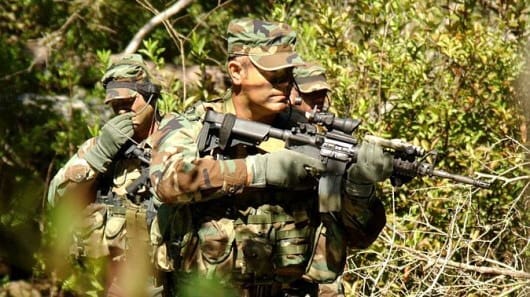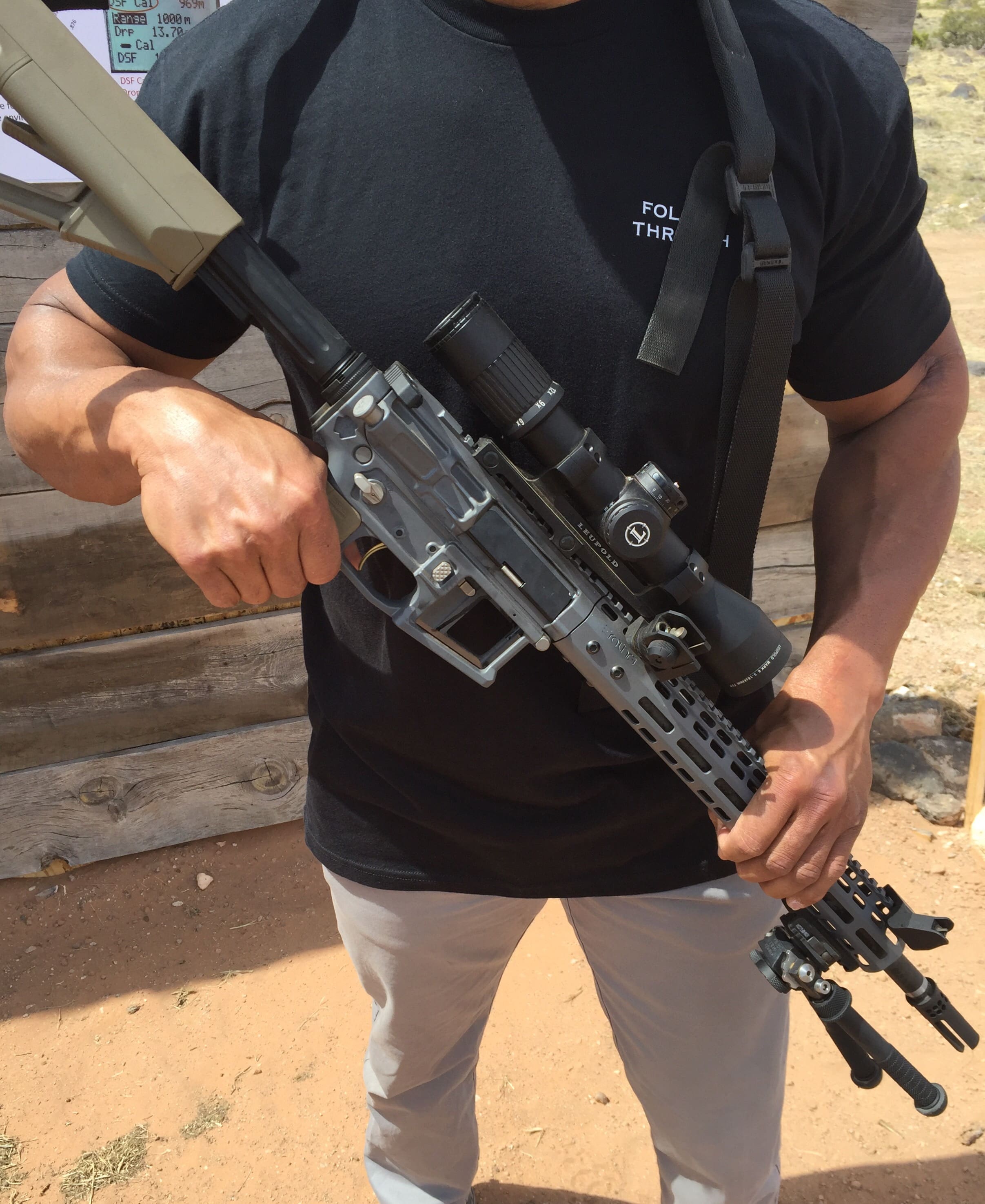Recently, I saw someone on Instagram bring up Buck Doyle’s technique for carrying a carbine in combat. As I had written something in this back in 2016, I thought it was worth sharing again.
This week I got to spend some time out in Utah with Buck Doyle, owner of Follow Through Consulting. Buck is very well known and respected in the Marine Reconnaissance and MARSOC communities, as well as industry. I expected to learn a lot from him and he did not disappoint.
One quick takeaway I picked up during the scoped carbine course he presented for hosts Proof Research, Erathr3, Leupold and Surefire, was this weapon grip for fast movement. I thought it was a great, quick share because anyone can easily adopt it on their own.
In the Army, I was taught to carry my rifle in a modified port arms by wrapping the fingers of my firing hand around the pistol grip with my trigger finger extended along the lower receiver above the trigger. Alternatively, I’ve seen guys extend their finger across the trigger with their fingertip resting on the magwell, as seen above. Additionally, I was taught to position my support hand under the forearm with my finger and thumb holding it securely.
Buck was taught the same thing in the Marine Corps. But the realities of combat taught him to modify this grip. Twice, he injured his trigger finger during falls in combat while rushing from one position to another. The first time he dislocated his finger and on the second, he sprained it. He said the sprain was worse because it took longer to heal. Once Buck started wrapping all of his fingers around the pistol grip, he didn’t injure it again.
I told Buck, “That makes sense for the firing hand, but what gives with the upside down grip on the support hand?” He told me that this method of carry served two functions. First, it serves the four rules of firearms safery quite well. It forces the muzzle down in a safe direction during movements. If you stumble, you won’t bring your muzzle up in the air like you would with the more tradtional port-style carry. Second, you can more naturally pull the weapon down into yourself in a full fall.
An important note. Buck adopted this technique for moving rapidly (ie running) while in combat. He fully acknowledges that you will have to transition your grip to shoot your weapon.
One of the things I find most refreshing about Buck Doyle is that there’s no BS. I talked to him about the grip and asked him what he called it. Unlike many tactical trainers, he didn’t have some fancy, trademarked name for it. For Buck, this wasn’t some theory-based technique he had dreamed up, but was based on years of actual combat as a Marine. It’s just an adaptation of a long-standing technique for use in certain circumstances. That’s the kind of thing you take away.
For those curious, the rifle is by Erathr3 with a PROOF Research barrel. The scope is Leupold and furniture by Magpul. More on all of that soon, but yes, I was hitting steel at 1164 meters with this 5.56mm package.
If you’re interested in learning more about Follow Through Consulting, visit www.followthroughconsulting.com.





I like that a lot. Thanks for sharing this info again.
Buck seems like a great guy, from the few times I’ve talked to him. Probably pretty quick to transition that to a barricade clamp. Tremor3 reticle?
Good write up, the explanation makes a lot of sense.
On a kind of side note, is EraThr3 still a thing? I hadn’t heard a thing about them in quite some time…and the link gives me a warning saying it might be a fake site.
That makes a LOT of sense.
Incidentally, there was a Bn. commander of 2/504, 82nd Abn. who instigated that same pistol-grip hold back in the late 80’s / early 90’s – he called it the “Strike-Hold!” hold. I don’t think it also included the reverse hold on the forearm though, and it was implemented as an SOP after my ETS date (a younger veteran told me about it a couple of years ago). Interesting coincidence.
Was that Petraus? I read he did something similar after being shot on a range by one of his troops circa that timeframe.
Is 5.56 any good at 1164 meters? Or, is that a pointless exercise?
I asked the question but don’t have the math. I hit the target. I don’t think there’s any energy at that point, but it would definitely freak the guy you are shooting at out.
A 16” shooting 5.56 pressure 77gr will have ~130 ft/lbs of energy at that distance, with ~870 ft/a velocity.
So, about 40 ft/lbs more energy than a 22lr at the muzzle. Definitely could still be lethal. And at the very least, a threat hit at that distance is likely go head off for medical care rather than continue on with the long range fight.
* An 18” barrel will be nearly identical in performance at that range.
I’m amazed. It was basically indirect fire.
Haha. Definitely some impressive shooting with that cartridge at that range. Wind effects are strong on 5.56 bullets past mid-range.
I recall usmc training in 92, we were told to point our m16 barrel towards the target with the stock pinned against our side as we ran forward to the next position, the rifle for the most part would stay forward and somewhat level while running. This seemed to be better way than running with the m16 using the port carry method where the barrel points to the side away from the threat. I appreciate the information you provided as it makes sense and would provide better control of your weapon.
Good, well thought out positioning. But I will never forget falling face-forward into slick mud, during a rainstorm, and jamming about 4″ inches of mud up the muzzle of an M-16. Then, while on the move, assembling a cleaning rod, breaking open the rifle, holding the removed bolt carrier group and upper in one hand, and running the cleaning rod from the breech to clear the mud obstruction. Since that rainy night I’ve always had a healthy paranoia about the muzzle down carry – I still carry muzzle down, but am very aware of the potential of bore obstruction in case of a fall.